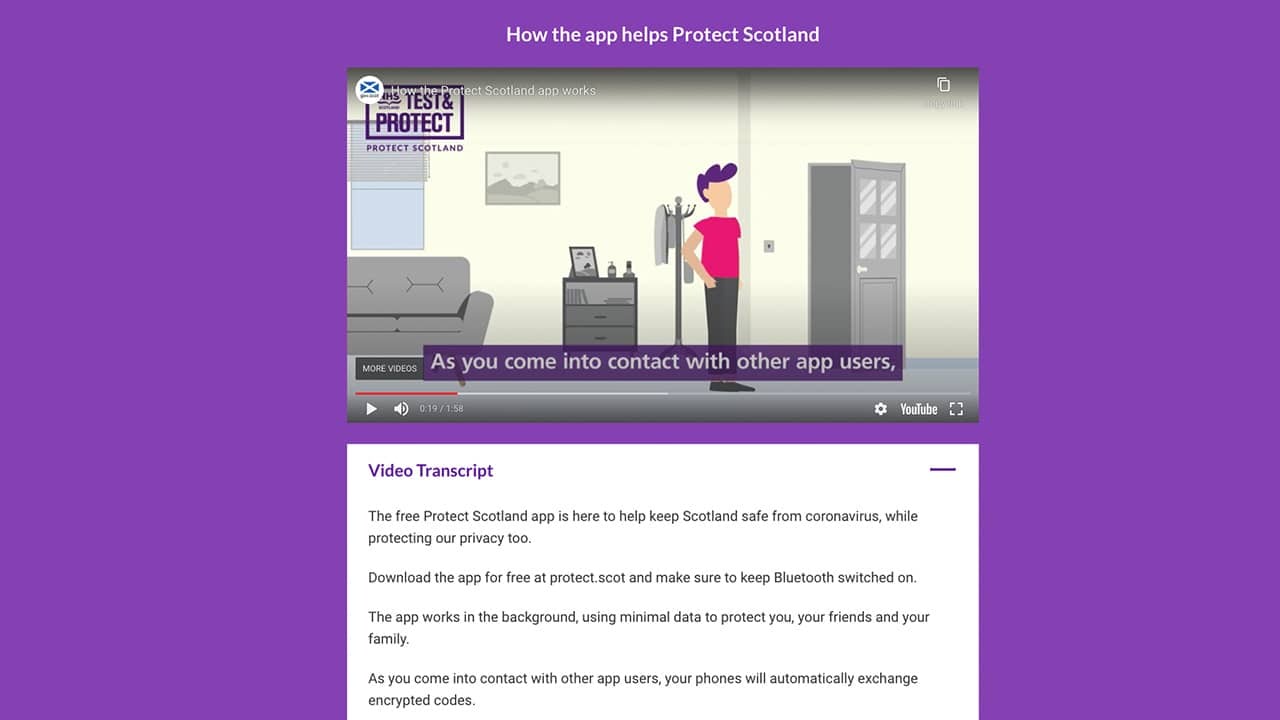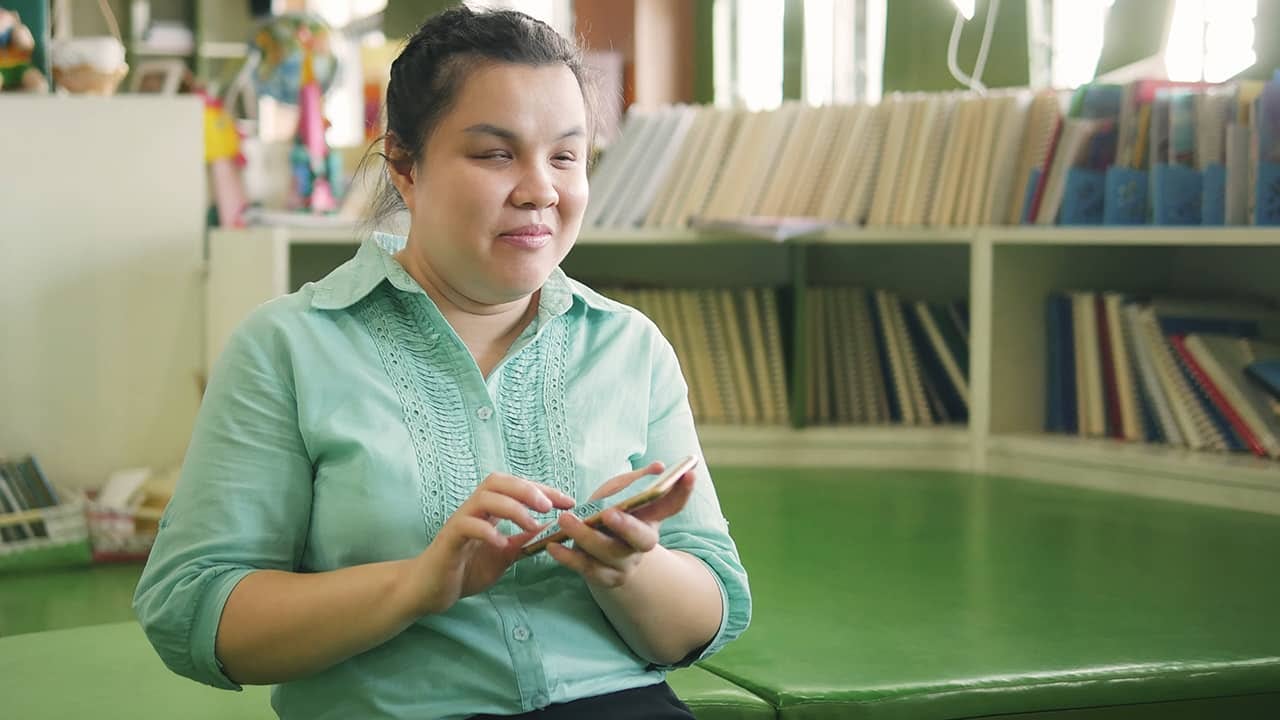Accessibility is about making sure your content can be accessed and read by as many people as possible. It means delivering your services or products to everyone, which is great for your audience – and great for your business.
For your marketing to be truly effective, you need to reach everyone in your target audience. Do the choices you make in your marketing unknowingly exclude some of the 13 million disabled consumers in the UK?
Think about your marketing materials, for example, your videos, documents, marketing emails, event stands, website, app, whitepapers, leaflets, and so on. Can their content be easily accessed, read, and understood by everyone? Or would someone with a physical, visual or hearing impairment experience a problem with them?

By ignoring disabled people, businesses are not only doing the wrong thing and potentially breaking the law, but they are also missing out on a potential £2.74bn market in the UK.
3 in 4 disabled people and their families have walked away from a UK business citing poor accessibility and/or poor customer service
In a survey by Scope, half of the people surveyed who experienced problems buying goods or services through a website, app or in-store machine did not purchase the product. Another 48% found a different provider and purchased their products elsewhere.
In this article, we talk about this wider audience of people with disabilities and impairments, the importance of being inclusive, how you can benefit from accessible marketing and how inclusive design is the key to improving your marketing reach.
Reach an audience of over 13 million people
UK audience
There are around 27 million households in the UK. Over 11 million (that’s 40%) of these households include at least one disabled member. One in five people in the UK has a disability. That’s approximately 13.3 million people, including:
- the 8.1 million people with significant vision impairments, including 2 million people who are blind
- people with hearing impairments
- people with learning disabilities or cognitive limitations, including ADD, Asperger, dyslexia, etc.
- people who have trouble lifting their hand and have limited movement
- people who have difficulty speaking
Global audience
Businesses that trade internationally are missing out on significantly more potential customers with disabilities. Around a billion people worldwide (that’s 15% of the global population) have some form of impairment.
Types of accessibility
There are many different types of disabilities and impairments:
Visual accessibility
When thinking about visual accessibility, we must consider:
- non-sighted people
- people with low-vision
- people with obstructed vision
- people with issues caused by old age
Worldwide, 36 million people are blind, and 217 million have moderate to severe vision impairment.
Colour blindness
Colour vision deficiency leads to problems distinguishing shades of red, yellow, and green. In rare cases, some people have trouble with blues, greens and yellows.
Physical accessibility
Physical accessibility includes people with dexterity and precision issues. People with severe motor impairments rely on assistive technology. This technology includes specialised keyboards, eye trackers, and single buttons. These tools enable people to navigate around websites, replacing the keyboard and mouse.
Cognitive accessibility
If a person has problems processing information, they have a cognitive disability, which leads to issues with fluid intelligence and crystalised intelligence. Crystalised intelligence is how we use skills, knowledge, and experience. It relies on accessing information from long-term memory.
Also included in this category are issues with literacy and numeracy.
Emotional or behavioural accessibility
Emotional or behavioural disabilities cover a wide range of often complex mental health conditions, including:
- Anxiety disorders
- Depression
- Obsessive-Compulsive Disorder (OCD)
- Panic disorder
- Insomnia
Socio-economic accessibility
Socio-economic accessibility relates to issues of representation, diversity, and inclusion. Also covered in this category are costs and affordability. Age, gender, social class, education, employment, ethnicity, and location are also relevant.
Temporary disabilities
The disabilities covered so far are usually permanent. Yet, there are often situations in which even fully-abled people are ‘temporarily disabled’. Examples include how a temporary arm injury may prevent you from being able to use a mouse.
Situational disabilities
There are also ‘situational disabilities’ that may affect us all. For example, screen glare on a sunny day or using a mobile on public transport – slow connection, limited space to move, and a bumpy ride!
Is accessibility mostly about websites?
When we think of accessibility, we immediately think about websites, or maybe physical access to a building. And while website accessibility and easy access to buildings for everyone is incredibly important, being truly inclusive goes far beyond these allowances.
Accessible marketing covers all communication mediums, including printed materials, emails, advertisements, signage, and even Zoom calls (showing your face so people can lip read, for example). It considers temporary situations like trying to read your marketing email on a screen in bright sunlight. If the colour contrast between the text and the background colour isn’t strong enough, people will struggle.

Providing captions on videos can help deaf people access your digital marketing content, as well as greatly benefitting people in environments like a crowded bus. Another example would be ensuring your advert is translated correctly into the language of the country you’re selling to, ensuring that the right tone carries across so your message can be easily understood without using colloquialisms used in the UK. Some common phrases we use in the UK rarely translate well to German.
We need to anticipate situations like these so we can become as inclusive, clear, and helpful as possible. Accessible marketing is primarily about getting the basics right in terms of your content, in whatever format it takes. Can your content be read, heard, and interpreted? Can it be easily understood?
Why you can’t afford not to be inclusive
It’s the right thing to do
Businesses must respond to a changing world. They must prevent their customers from facing indirect discrimination. As accessibility awareness increases, so does the legal and ethical obligation to make your content and digital services accessible.
There are legal obligations
The Equality Act 2010 prohibits businesses that provide services to the public from discriminating against, harassing and victimising certain classes of persons (for example, age, disability, and race). This act also places an obligation on businesses to make reasonable adjustments for disabled people.

In 2019, Domino’s Pizza lost a legal case in the US after its website and app were found to be inaccessible to blind people. While there aren’t any equally high profile cases here in the UK yet, the risks of legal action are increasingly high for businesses that ignore the law in this area.
You can reach a £2.74bn market

By ignoring disabled people, businesses are missing out on a potential £2.74bn market. This market is known as the ‘purple pound’, and by ensuring your marketing has considered this audience, you will be able to reach them and their spending power.
If you cater to the needs of people who are currently ‘locked out’ of your marketing (for example, your website or emails), you will significantly increase your market reach.
Top spending categories for disabled households
According to Scope, these are the top spending categories for disabled households in the UK:
- Food and drink
- Personal transport
- Recreation and culture
- Finance and insurance
- Clothing and footwear
- Entertainment
- Personal care products/services
- Public transport and taxis
- Home and garden
- Energy
The same Scope survey found that households with disabled people spend, on average, 65% less on education but would like to spend more. They spend 25% less on entertainment but, again, would like to spend more.
It’s clear that providing better experiences for disabled people will, firstly and most importantly, help them to achieve their goals. But it will also generate more income.
You will enhance your brand’s reputation
People want to buy from companies they feel care about them. Brands that care or matter to us generate significantly higher Key Performance Indicators (KPIs). For example, engineers at Apple have been accessibility innovators since the company began, providing features like the VoiceOver screen reader and Braille display.
Many disabled people struggle to use apps and websites because their needs weren’t considered when it was built and tested. They come across videos every day that don’t have captions or transcripts, and they are frustrated with advertising that has left them out. So coming across your marketing that has included them will be a pleasant surprise, boosting your reputation in their eyes. Good service travels fast and bad service travels even faster.
And being an inclusive operation and demonstrating social responsibility will certainly build positive public relations for you.
You will build brand loyalty
People return to apps and websites that are easy to use, engaging, and help them achieve their goals in their daily lives. They consume more of the same content they have enjoyed before. They remember positive experiences and become loyal customers. This is especially relevant if you offer a product or service that people may buy regularly.
Disabled people and their families have a higher level of brand loyalty than the average customer (source: We Are Purple).
You will become more competitive
Will your competitors put as much thought and effort into creating accessible marketing materials and campaigns? This is your chance to get a competitive edge, to lead the way in your industry, and get ahead of the competition.
WebAIM’s recent study found that 98% of all top websites failed basic web accessibility standards in 2019. So it’s clear that accessible websites, apps and digital services can give your business a competitive edge. You can dominate your particular niche by serving customers that your competitors are overlooking.
Your content will be easier to read and understand
Plain language benefits everyone, including people with cognitive disabilities, low reading literacy, and people who are encountering an unfamiliar topic or language.
Here is a quick summary of what it means to write content for clarity and comprehension:
- Put information in a logical order, with the important information first
- Use an active voice, with a clear audience in mind when you are writing
- Use familiar language that fits your audience and context
- Provide definitions for unusual words and abbreviations
- Test your content; ask colleagues, friends, or others who you consider to be part of the target audience to read your content – is the content meaningful and understandable to them?
And if your marketing copy is clear to your whole audience, your campaigns will have a great chance of success.
You will enhance the user experience of your website, mobile app, and landing pages for everyone
Accessibility and usability are intertwined but very different considerations. Accessibility is about removing barriers so people with disabilities can perceive, operate, and understand the thing you offer. Usability is about addressing general user needs so what you offer is effective, and people enjoy using it (they have a positive user experience).

For example, an accessible web page is easier to use for everyone because as you remove barriers, you are also reducing complexity, which naturally improves usability and provides a good user experience.
Improve your Search Engine Optimisation (SEO) and increase your website traffic
The best-practice techniques for website accessibility also help improve your website’s SEO. You will be making your visitors happy and search engines like Google happy too. And a happy Google algorithm means you will rank higher in the search engine results, which in turn means more visitors and more business coming your way.
We predict that in 2022 search engine giants like Google will prioritise websites that are accessible over sites that exclude disabled people.
Become an inclusive business/organisation
Strategy and leadership
Include disabled people in your business, marketing, and website strategies. Plan your approach for adapting your marketing for this audience and including everyone in your marketing.
Ensure someone in your organisation has the time and authority to implement this approach and see it through to fruition.
Culture
Accessibility is commonly misunderstood and, sadly, even ignored. Changing a culture so people in a business or organisation understand what accessibility is and why it’s so important is a process that takes time and ongoing action.
Here are some actions that would help with this process:
- Communicate about how being an inclusive organisation is part of the strategy
- Ensure someone leads on inclusive thinking and accessibility
- Spread ‘Accessibility Champions’ throughout your organisation
- Communicate regularly about the work going into accessibility, updates on progress, feedback from customers, and so on
- Provide training to increase awareness of accessibility and begin to instil inclusive thinking
- Hire people who have experience and passion in this area (for example, a marketing officer or manager who creates campaigns with an inclusive approach)
- Include accessibility in your Quality Assurance processes
Lead with inclusive design
Inclusive design is a methodology, born out of digital environments, that enables and draws on the full range of human diversity. It means to create something so that it can be accessed and used by as many people as possible, regardless of age, gender and disability. It ensures organisations can go beyond simply providing alternative formats on request.

Scope found that 75% of survey respondents felt their business was losing out due to poor inclusive design. Ultimately, using inclusive design in your marketing will help you reach more potential customers and grow your business.
Adapt your existing materials
Applying inclusive design to your marketing will mean updating or potentially recreating the templates for websites, landing pages, emails, printed materials, and adverts, so they are all accessible.
However, wholesale changes to your marketing templates are not always required. There may be some small changes you can make that will make a big difference:
- Improve colour contrast so text is easier to read
- Change the content structure so headings are presented in the correct order
- Ensure all future videos include subtitles and transcripts
- Increase font sizes to improve readability
- Simplify the language you use
Ensure your website is fully accessible
A fully accessible website is an essential component of accessible marketing. Website accessibility is a vast subject with too much to cover here but, in summary, here are just some actions you’ll need to take:
- Provide multiple methods of navigating through content
- Ensure your content can be read when the visitor has increased the zoom level in their browser to 300%
- Structure your content with the most important information presented first
- Ensure functionality can adapt to different devices
- Provide alternative text for images
- Perform accessibility testing using both an automated and manual process covering your main templates and popular content
Where do you start with accessible marketing?
Audit your assets
Perform an audit of your marketing materials, including your website, to help set a baseline for how accessible you are right now. There are many tools out there to help test accessibility on your website, emails, and digital documents. For other things like printed material, adverts, and live events, you can ask questions like these:
- Can they be opened?
- Can they be read?
- Can people find the information they need?
- Can they be understood?
- Is your event stand physically accessible?
- Where are you distributing your materials: can they be physically reached?
- Will your website work for someone who can only navigate using a keyboard?
- Can your video be understood without sound?
- Can your video be understood without vision?
Answering these questions means being empathic with your disabled audience; putting yourself in their shoes (unless you can ask them directly, of course)
Perform an accessibility audit
Performing an accessibility audit isn’t as daunting as it sounds. If you follow a clear process and are able to motivate everyone involved, then it’s something that can be achieved without too much stress. The time required to perform an audit will vary, depending on the complexity of your website.
Here is an overview of the accessibility self-audit process:
- Automated tools test
Automated tools will help you understand your website's level of accessibility with the click of a button. - Keyboard test
This tests what it's like for someone to use your website using only their keyboard. Set your mouse aside and try browsing your website now for a quick taste of this important test. - Screen reader test
This tests how your website performs when a visitor relies on a screen reader to consume your content. A screen reader enables people who are blind or visually impaired to use their computer and access content in documents and online. It is a type of assistive technology that renders text and image content as speech or braille output. - Colour blindness and vision impairment test
The next step tests how your website would perform for people with colour blindness or vision impairments. - Zoom test
This tests how your website works when people with visual impairments adjust their browser’s zoom settings to make content easier to read. Try increasing your browser’s zoom level to 300% now as a quick example. You can do this in the settings or the menu at the top of your browser. - Text spacing test
A visitor with a cognitive disability like dyslexia can adjust paragraph and font spacing to make content easier to read. This test aims to replicate the most common settings they use. - Colour contrast test
There must be sufficient contrast between your background colours or images and the text in the foreground. - Record the issues you find
You’ll need a method of recording and sharing the issues you have discovered during your audit. This can be done using online tools like Trello, Basecamp, or Microsoft Teams. - Prioritise the issues you find
Prioritising the issues you have found is done by assessing how seriously they impact your visitors. Serious examples include: - Pages do not have a proper heading structure
- The reading level required to read content is higher than early secondary school level
- Missing alternative (alt) text on images
- Poor contrast between background colours and text colours
- Links are difficult to see for visitors who can’t see some or all colours
- Pages scroll horizontally when the page zoom level is increased
- Fix the issues you have found
You should be able to fix some of the issues you discover. It’s likely you will need to write or improve the alt text on your images, diagrams, graphics, and other media. Videos are often missing captions and transcripts too. But some issues may go beyond content and require a website designer or developer to fix. - Update your accessibility statement
Public funded organisations like universities, councils, and schools are required to present an accessibility statement to list where they don’t meet current accessibility standards. - Plan to re-audit next year
Regular content changes and additions mean that you will need to re-audit for accessibility on a regular basis. For most websites, this means performing a yearly audit. For larger organisations, something more regular may be required. Depending on the amount of content published during the year, this could be every quarter or six months.
Look out for our future articles that will provide full details on the whys, hows, and whats of running your first accessibility self-audit. We will have an in-depth look at the tools and techniques required to run an accessibility audit yourself. The article will also cover what accessibility issues you can expect to find and how best to solve them.
Expand your market research
If you undertake market research activity – however informal or formal – consider extending these activities to include disabled consumers. You will get some valuable insights you can use to ensure they are considered in your future marketing.
Develop an accessibility case study
Start small with an example. Recreate a piece of content (for example, a marketing email) so it’s both fully accessible and an effective part of your marketing. If done well, this can serve as a positive example of how investing time and money into inclusive design can be hugely beneficial.
Test with your audience
Statistically, you will probably already have customers who are vision, hearing, or mobility impaired. Develop a new, accessible piece of content and share your work with them prior to launch. You can then receive feedback upfront from those audience segments before releasing your campaign to the public.
If you aren’t able to work with people who have a disability, you can test your marketing materials against these questions:
Physical - What kind of movement must a user perform to interact with your website or content?
Visual - What shapes, colours, text, and graphics must a user be able to see in order to consume your content?
Sounds - What sound does your content produce, and what alternatives do you need to provide for people who won’t be able to hear it?
cognitive experience - How much time must a user spend with your content to truly interpret and understand it?
Start planning and act soon to benefit
The sooner you start implementing accessibility across your business strategy, the earlier you can start reaping the rewards!
We hope this article helped explain how you can benefit from accessible marketing and just some of the actions you can take to reach a wider audience.
Want to talk to us about accessible marketing?
We believe that inclusive design is the key to improving your marketing reach. Here at zen, we pride ourselves on creating campaigns, apps and websites that are open and available to everyone. We use inclusive design practices across all of our websites, mobile apps, and marketing materials.
This approach benefits our clients and, to be a bit selfish for a moment, it helps our business too. A wider audience for our creations means more happy customers and repeat business for us.
Need some expertise in this area? We're available to have a no-obligation chat over the phone or a video call.
If you fancy a virtual coffee to talk further, simply get in touch.
Call us on 01382 808 808, or ping an email over to [email protected], and we'll be happy to help!